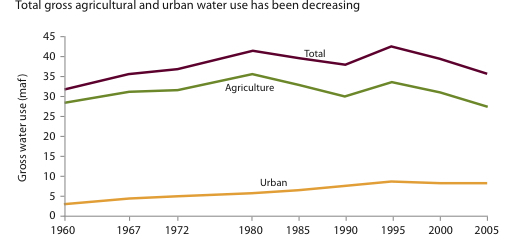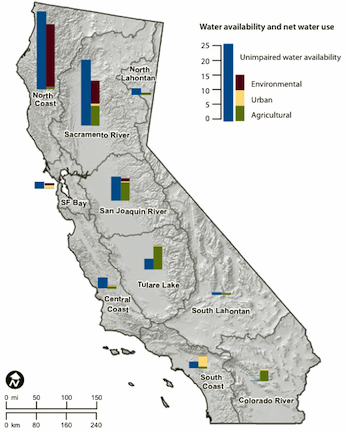Water—Who uses how much?
By Jeffrey MountWhereas agriculture used to consume 80 percent of the state’s water supply, today 46 percent of captured and storedwater goes to environmental purposes, such as rebuilding wetlands. Meanwhile 43 percent goes to farming and 11 percent to municipal uses.
— The Economist, October 2009
This excerpt is from an article that focused on the never-ending skirmishes over how to divide the water of California and simultaneously meet the objectives of water supply and ecosystem health
 in the Delta. The statement, which appears to be attributed to Tom
Birmingham of Westlands Water District, is both a mangling of the facts
and an apples-to-oranges comparison.
in the Delta. The statement, which appears to be attributed to Tom
Birmingham of Westlands Water District, is both a mangling of the facts
and an apples-to-oranges comparison.Interpreted literally, it implies that agricultural water use has been reduced from 80 percent to 43 percent with a transfer of agriculture’s use of water to the environment. Reading the news over the past few years, it might have seemed like such a thing happened. It hasn’t, of course.

The
figure shows gross water use. Urban includes residential and
nonagricultural business uses. Pre-2000 estimates are adjusted to levels
that would have been used in a year of nominal rainfall. Estimates for
2000 and 2005 are for actual use; both years had near-normal
precipitation. Estimates omit conveyance losses, which account for 6 percent to 9 percent of the total. Source: Author’s calculations
for 6 percent to 9 percent of the total. Source: Author’s calculations using data from California Water Plan Update
using data from California Water Plan Update
 for 6 percent to 9 percent of the total. Source: Author’s calculations
for 6 percent to 9 percent of the total. Source: Author’s calculations using data from California Water Plan Update
using data from California Water Plan Update
If this were the case, we would have seen a dramatic
decline in agricultural water use since the implementation of
environmental laws. We have seen a decline, but it is nothing close to
what is implied.
This statement requires some disentangling to separate the facts from
the factoids (near-facts which are artfully spun). The roots of
confusion lie with the change in how the California Department of Water
Resources (DWR) reports water use. Historically, DWR only counted water that was applied
water use. Historically, DWR only counted water that was applied for economic uses. Under this scheme roughly 80 percent of water went
to agriculture with the remaining 20 percent going to urban uses.
for economic uses. Under this scheme roughly 80 percent of water went
to agriculture with the remaining 20 percent going to urban uses.Under the new reporting system, gross water use includes both the applied water for urban and agricultural use, as well as that set aside for flow requirements to meet habitat and water quality needs. This is the source of the second part of the above statement. A more accurate figure is roughly 40 percent agriculture, 10 percent urban and 50 percent environment.
Sounds like the environment is taking all the water after all, even with the new accounting system. But this is a larger total volume of water than in the old accounting system, since environmental water is now added in to the mix. This accounting method is both flawed and misleading.

Net
water use far exceed local supplies in the southern half of the state.
Annual average values for 1998-2005 are in millions of acre-feet. Source: California Department of Water Resources, 2009
When you examine water use within the interconnected network of California that feeds farms and cities, use is roughly 52 percent agricultural, 14 percent urban and 33 percent environmental. While a big difference, even this overstates the environmental take.
When you account based on net water use—meaning water that is lost to evapotranspiration or salt sinks and not returned to rivers or groundwater for alternative uses—this translates to 62 percent agricultural, 16 percent urban and 22 percent environmental. And some of that environmental water is used to keep water quality high enough for drinking.

Notes:
Urban uses include 0.1 maf/year of gross water use (and no net water
use) for cooling thermoelectric power generation. Some land grows crops
more than once a year, so irrigated crop acreagee exceeds irrigated land
area. Statewide irrigated cropland is about 9.2 million acres.
Source: Author’s calculations using regional 2009 DWR data.
Source: Author’s calculations using regional 2009 DWR data.
Patrick Moynihan once famously stated, “we are all entitled to our own opinions, not our own facts.” We need to use water accounting standards that are rational and reflect real differences. There is of course much rhetorical incentive for each group of stakeholders to use water accounting systems where they look unimportant, or their favorite villain looks important – sort of “combat accounting.” On the who-uses-how-much debate, any standard should be net usage of water within the interconnected network of California. All other comparisons simply muddy the waters.
Further reading
Hanak, E., J. Lund, A. Dinar, B. Gray, R. Howitt, J. Mount, P. Moyle, and B. Thompson, Managing California’s Water: From Conflict to Reconciliation, Public Policy Institute of California, San Francisco, CA, 500 pp., February 2011.
Hanak, E., J. Lund, A. Dinar, B. Gray, R. Howitt, J. Mount, P. Moyle, and B. Thompson, “Myths of California Water – Implications and Reality,” West-Northwest Journal of Environmental Law and Policy, Vol. 16, No. 1, Winter 2010.
California Water Plan: http://www.waterplan.water.ca.gov/
Update
Mount, J., Freeman, E., Lund, J. , Water Use in California, Public Policy Institute of California, July 2014

No comments:
Post a Comment